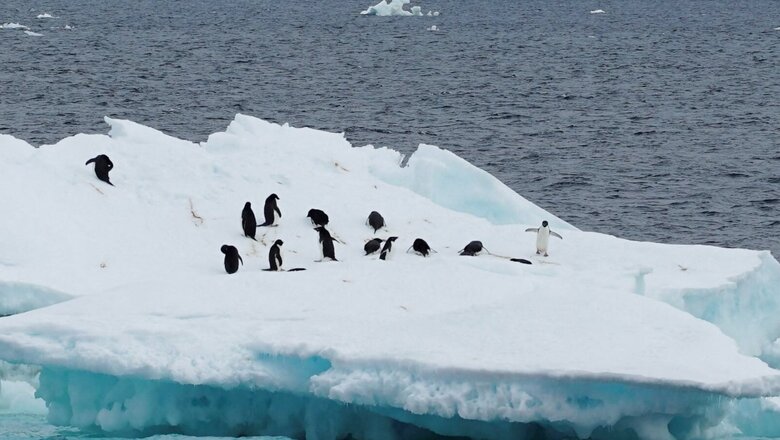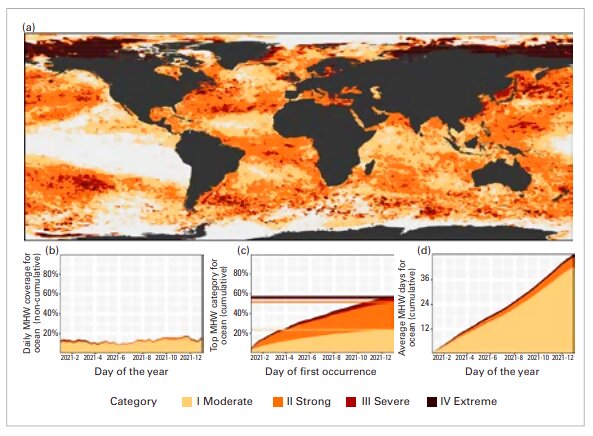
views
The unabated warming has fuelled a record rise in global sea levels over the last decade, said the latest State of the Global Climate in 2021 report, warning of its long-lasting impacts on global weather systems. According to the multi-agency flagship report, the mean sea levels have increased at more than double the previous rate.
The oceans were swelling by 2.1 mm per year between 1993 and 2002, but after 2013, they began rising by 4.5 mm every year – the fastest-ever, due to accelerated loss of ice mass from the ice sheets. The upper 2,000m depth of the ocean continued to warm – a change that is irreversible over the next thousand years. The ocean heat content in 2021 was in fact the highest on record, exceeding the 2020 value, and is penetrating to even deeper levels, the report highlighted.

Much of the ocean experienced at least one strong marine heatwave at some point last year. According to climate experts, several regions like the southwest Indian Ocean saw substantially faster sea-level rise than the global mean, threatening the lives of hundreds of millions of coastal dwellers who will be rendered more vulnerable to tropical cyclones, and other extreme events. The most severe cyclone of the north Indian Ocean season in 2021 was Tauktae, which tracked north off the west coast of India, with a peak three-minute sustained wind speed of 50-53 m per second, before making landfall in Gujarat on May 17 at slightly below peak intensity, equalling the strongest known landfall in Gujarat. At least 144 deaths were reported in India and four in Pakistan.
Warming continues unabated
According to the report released by the World Meteorological Organisation (WMO) on Wednesday, which will be used as an official document for the UN Climate Change negotiations known as COP27 to take place in Egypt later this year, the world continues to get warmer at an alarming rate, with the last seven years, 2015 to 2021, recorded to be the seven warmest till date. The global annual mean temperature in 2021 was around 1.11 ±0.13°C above the 1850-1900 pre-industrial average. The year was slightly less warm than some recent years due to the temporary cooling effect of moderate La Niña events (sea surface temperatures) at the start and end of the year, but the report emphasised that it did not reverse the overall trend of rising temperatures. 2021 was in fact 0.22°C to 0.29°C warmer than 2011 when the last significant La Niña was seen.
It also noted that many displacement situations triggered by extreme weather events have become prolonged or protracted for people unable to return to their former homes or without options for integrating locally or settling elsewhere. At the beginning of 2021, at least 7 million people were living in internal displacement following disasters related to natural hazard events in previous years, according to the Internal Displacement Monitoring Centre (IDMC). The largest numbers of people in this situation were in Afghanistan, India, and Pakistan, followed by Ethiopia, Sudan, Bangladesh, Niger, and Yemen.
Emissions at global high
Data indicates that greenhouse gas concentrations continued to increase in 2021 and early 2022. Since oceans absorb around 23% of the annual emissions of anthropogenic CO2 to the atmosphere, it is also turning them acidic, and threatening the marine ecosystem. As the pH of the ocean decreases, its capacity to absorb CO2 from the atmosphere also declines.
While 2020-2021 saw less melting of glaciers than in recent years, scientists said there was a clear trend towards an acceleration of mass loss on multi-decadal timescales. On average, the world’s reference glaciers have thinned by 33.5 metres (ice-equivalent) since 1950, with 76% of this thinning since 1980. Greenland experienced an exceptional mid-August melt event and the first-ever recorded rainfall at Summit Station, the highest point on the ice sheet at an altitude of 3 216 m. The ozone hole over the Antarctic was unusually large and deep, reaching its maximum area of 24.8 million km2 (the size of Africa) as a result of a strong and stable polar vortex and colder than average conditions in the lower stratosphere, the report underscored.
The experts highlighted that four key climate change indicators – greenhouse gas concentrations, sea-level rise, ocean heat, and ocean acidification – set new records in 2021, signalling how the human activities are causing planetary-scale changes on land, in the ocean, and in the atmosphere, with harmful and long-lasting ramifications for sustainable development and ecosystems. “It is just a matter of time before we see another warmest year on record,” said WMO Secretary-General Petteri Taalas. “Our climate is changing before our eyes. The heat trapped by human-induced greenhouse gases will warm the planet for many generations to come. Some glaciers have reached the point of no return and this will have long-term repercussions in a world in which more than two billion people already experience water stress.”
No future without renewables
Drawing attention to the world’s current energy crisis, United Nations Secretary-General António Guterres used the WMO flagship report to urge governments to fast-track and streamline approvals of solar and wind projects, modernise grids and form a coalition to streamline supply chains for renewable energy technology and raw materials which is now concentrated in a handful of countries. “The global energy system is broken and bringing us ever closer to climate catastrophe. The good news is that the lifeline is right in front of us,” said Guterres as he called for urgent action to grab the “low-hanging fruit” of transforming energy systems away from the “dead end” of fossil fuels. “The only sustainable future is a renewable one.”
Guterres proposed five critical actions to jump-start the renewable energy transition, including an end to subsidies on fossil fuels which amount to roughly $11 million per minute and creating a level playing field for renewables. “Each year, governments around the world pour around half a trillion dollars into artificially lowering the price of fossil fuels — more than triple what renewables receive. While people suffer from high prices at the pump, the oil and gas industry is raking in billions from a distorted market. This scandal must stop,” he said. “If we act together, the renewable energy transformation can be the peace project of the 21st century.”
Read all the Latest News here




















Comments
0 comment